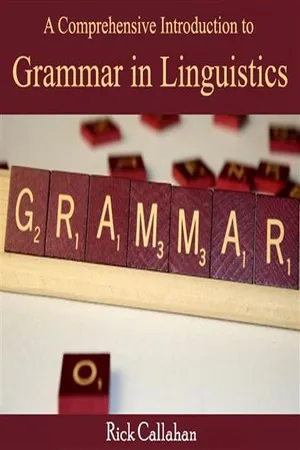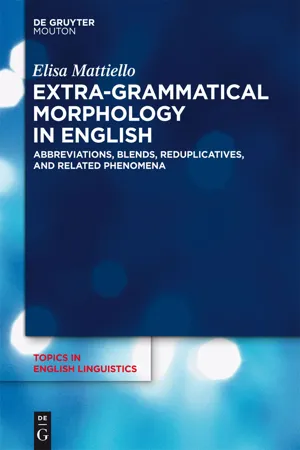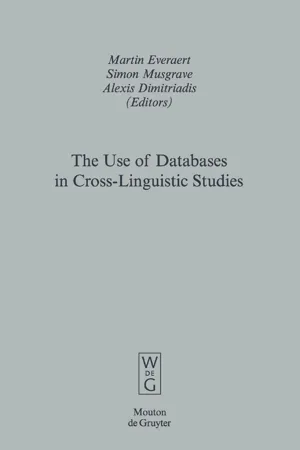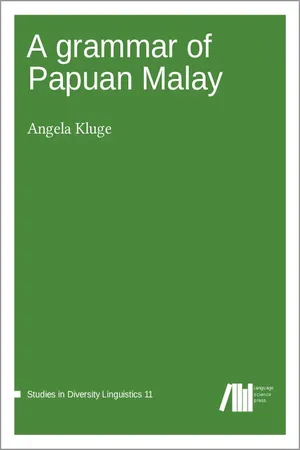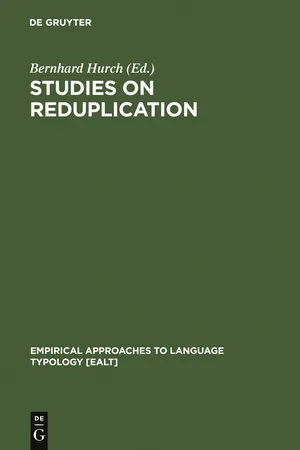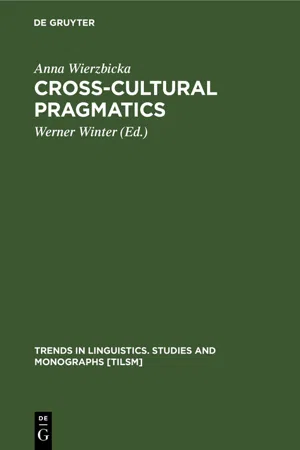Languages & Linguistics
Reduplication
Reduplication is a linguistic process that involves repeating all or part of a word to create a new word with a different meaning. It is found in many languages and can serve various functions, such as indicating plurality, intensifying meaning, or forming new words. Reduplication can be full or partial, and can occur at the beginning, middle, or end of a word.
Written by Perlego with AI-assistance
Related key terms
1 of 5
11 Key excerpts on "Reduplication"
- No longer available |Learn more
- (Author)
- 2014(Publication Date)
- University Publications(Publisher)
________________________ WORLD TECHNOLOGIES ________________________ Chapter 4 Reduplication Reduplication in linguistics is a morphological process in which the root or stem of a word (or part of it) is repeated exactly or with a slight change. Reduplication is used in inflections to convey a grammatical function, such as plurality, intensification, etc., and in lexical derivation to create new words. It is often used when a speaker adopts a tone more expressive or figurative than ordinary speech and is also often, but not exclusively, iconic in meaning. Reduplication is found in a wide range of languages and language groups, though its level of linguistic productivity varies. Reduplication is the standard term for this phenomenon in the linguistics literature. Other terms that are occasionally used include cloning , doubling , duplication , and repetition . Typological description Form Reduplication is often described phonologically in one of two different ways: either (1) as reduplicated segments (sequences of consonants/vowels) or (2) as reduplicated prosodic units (syllables or moras). In addition to phonological description, Reduplication often needs to be described morphologically as a Reduplication of linguistic constituents (i.e. words, stems, roots). As a result, Reduplication is interesting theoretically as it involves the interface between phonology and morphology. The base is the word (or part of the word) that is to be copied. The reduplicated element is called the reduplicant , often abbreviated as RED or sometimes just R . In Reduplication, the reduplicant is most often repeated only once. However, in some languages, Reduplication can occur more than once, resulting in a tripled form, and not a duple as in most Reduplication. Triplication is the term for this phenomenon of copying three times. Pingelapese has both Reduplication and triplication. - eBook - PDF
- Niladri Sekhar Dash(Author)
- 2015(Publication Date)
- Cambridge University Press(Publisher)
There are multiple functions of Reduplication in a language. And these may be classified based on the part of speech of the final form, as shown below: (a) When nouns are reduplicated, they normally denote number, case, distribution, indefiniteness, reciprocity, size and associative qualities. (b) When verbs and adjectives are reduplicated, they usually denote plurality, distribution, collectivity, repetition, continuity, completion, co-activity, attenuation, intensity, transitivity, and reciprocity, etc. (c) When cardinal numbers are reduplicated, they usually express collectives, distributives, multiplicatives, and limitatives. (d) When bases are reduplicated (as in idiophones or onomatopoeia), they denote intensity, repetition, feelings, emotions, transitivity, recurrence, continuation, calls of birds and animals, sounds created by insects, sounds of metals and other physical objects, etc. Interpretation of Reduplication Let there be a reference to some of the interpretations on Reduplication as given by experts at different points of time in the context of understanding the phenomenon in general. According to Sapir, Reduplication is a process that involves repetition of all or some part of the radical element and which is generally employed to indicate such concepts as distribution, plurality, repetition, customary activity, increase in size, added intensity, continuance (Sapir, [1921] 2004). On the other hand, according to Bloomfield, Reduplication is an affix that consists of repeating parts of the underlying form (Bloomfield [1933a] 1984). STRUCTURE OF REDUPLICATED FORMS IN BENGALI 229 According to Nida (1949) Reduplication consists in the repetition of all or of some part of a root or stem. If the entire stem is repeated, the structure is considered as a repetitive compound, whereas, if only a part of the root or the stem is repeated, the repeated portion may be called a reduplicative (Nida, 1949). - eBook - PDF
Extra-grammatical Morphology in English
Abbreviations, Blends, Reduplicatives, and Related Phenomena
- Elisa Mattiello(Author)
- 2013(Publication Date)
- De Gruyter Mouton(Publisher)
A broad view includes within Reduplication both syntactic repetition, as in black black or long long (‘very long’) and syllabic repetition, as in kiwi, while the narrow view includes only repetition with nonsense bases, as in hubba hubba (Dienhart 1999). An exploration of existing definitions and taxonomies and a clarification of what is meant by Reduplication in this book are therefore in order. 5.1.1. Definition Reduplication is a word-formation process whereby some portion of a word is repeated, either totally, as in copy reduplicatives (e.g. gogo), or partially, with apophony of the (internal) vowel (as in riff-raff), or with rhyming con- stituents and apophony of the initial (consonant) sound (as in boogie- woogie). The rhyming type may exhibit two meaningful bases (as in walkie- Definition, delimitation, and classification 145 talkie), hence subcategorised by Merlini Barbaresi (2008: 231) as “rhyming compounds”. Some scholars provide much vaguer definitions, which are not as lan- guage-specific as the one just offered. Stockwell and Minkova (2001: 18), for instance, define Reduplication as a “rather unimportant, though often amusing, resource for expanding the vocabulary … in which part or all of a word is repeated”. Inkelas (2006: 417), dealing with various languages, similarly describes it as “a morphological word formation process in which some portion of a word is doubled”, and then distinguishes between the total and partial types, whereas in Inkelas and Zoll (2005: 1) Reduplication is described as “grammatical doubling”. A cross-linguistic study of (full and partial) Reduplication is to be found in Nadarajan (2006), who specifies that in Reduplication “some part of a base (a segment, syllable, morpheme) is repeated, either to the left, or to the right of the word or, occasionally, within the middle of the word” (p. 40). - Martin Everaert, Simon Musgrave, Alexis Dimitriadis, Martin Everaert, Simon Musgrave, Alexis Dimitriadis(Authors)
- 2009(Publication Date)
- De Gruyter Mouton(Publisher)
Reduplication is rare only from a narrowly European point of view: the languages of Europe do show Reduplication only in a very restricted way. If it is present at all, it is limited to expressive and onomatopoetic word forma-tions, and thus has a strong tendency to lexicalization. 3 It has been evident for a long time that linguistic theory has a heavy European bias – notwith-standing the universal orientation of the field. Thus, also the study of redu-plication has had difficulties for quite some time to transcend the examples from Latin perfect or Classical Greek aorist formation. The situation is dramatically different in other parts of the world. There are languages and whole language families that have more than one or even several produc-tive types of Reduplication, coherently denoting distinct grammatical and/or lexical operations. These types differ formally following the structure of the reduplicant, i.e., possible variants are full (complete) vs. partial redupli-cation, where the first denotes the repetition of the complete word form of the simplex, the second only a part of it. Moreover, in partial Reduplication forms may vary with respect to the (morphoprosodic) shape of the redupli-cant, e.g., full syllable, CV-, CV: -, etc. Interactions with other phonological, morphological or lexical strategies like fixed segmentism may complicate the patterns. Reduplication differs from both additive and modificatory morphological procedures in important aspects, but also comes close to them in others. So even if there might be several overlapping features, or if one could assume a continuum between affixation, modification and Reduplication, it is proba-bly best to establish Reduplication as a proper morphological operation in the strict sense and not to group it with other processes in order to avoid vagueness of description and of theoretical evaluation.- eBook - ePub
- Rita Finkbeiner, Ulrike Freywald, Rita Finkbeiner, Ulrike Freywald(Authors)
- 2018(Publication Date)
- De Gruyter Mouton(Publisher)
Accordingly, Section 3 tackles the question of where to locate Reduplication in the morphological component from a typological point of view, demonstrating that the operation has largely, if not exclusively, derivational traits, which will be ascribed to the semantically fairly concrete iconic basis of Reduplication. Section 4 utilizes these insights as another feature for delimiting syntactic repetitions and morphological Reduplications in potentially ambiguous cases of exact word repetition. Section 5 offers some conclusions and an outlook. 2 Formal versus functional approaches to Reduplication The cross-linguistically widespread morphological device of Reduplication can be relatively theory-neutrally defined as “[t]he systematic repetition of phonological material within a word for semantic or grammatical purposes” (Rubino 2005: 11). 41 It is well-known (see also Freywald and Finkbeiner’s introduction to this volume) that the process can be divided into full/total/complete Reduplication of units of morphology like words (1a), stems or roots (1b) and, more rarely, affixes (1c) as well as into partial Reduplication of phonologically circumscribed units like feet (2a), syllables (2b) and, more controversially (because formally overlapping with processes of consonant gemination or vowel lengthening), single segments (2c). As can be seen from the latter examples, a partial reduplicative exponent (often and henceforth called the reduplicant) may follow, precede or intrude into the morphological base. The functions of Reduplication across lexical categories typically pertain to some kind of plurality (1c), intensity (2a), diminution (2c) or a combination of the former (e.g. [2b]) and, a little less typically, to word-class changes (though frequently these display additional nuances of the former types, e.g - eBook - PDF
- Angela Kluge(Author)
- 2017(Publication Date)
- Language Science Press(Publisher)
4 Reduplication Reduplication refers to “the morphological operation in which a new word (form) is created by copying a word or a part thereof, and affixing that copy to the base” (Booij 2007: 321). In Papuan Malay, as in other Austronesian languages (Himmelmann 2005: 121–125), Reduplication is a very productive morphological device to derive new words. With respect to lexeme formation, Papuan Malay makes use of three different types of Reduplication: (1) full Reduplication, (2) partial Reduplication, and (3) imitative redupli- cation. Alternatively, Wiltshire & Marantz (1978: 558) refer to these Reduplication types as “exact total Reduplication”, “exact partial Reduplication”, and “inexact partial redupli- cation”, respectively. In terms of lexeme interpretation, a variety of meanings can be attributed to the reduplicated lexemes, such as plurality and diversity, intensity, or con- tinuation and repetition. Reduplication in terms of lexeme formation is described in §4.1 while lexeme interpre- tation is discussed in §4.2. This discussion is followed by a comparison of Reduplication across different eastern Malay varieties in §4.3. The main points of this chapter are sum- marized in §4.4. 4.1 Lexeme formation A phonological approach to Reduplication is Marantz’s (1982: 436) prosodic template model which views Reduplication as “normal affixation” with “one unique feature”, i.e. “the resemblance of the added material to the stem being reduplicated”. More specifically, “every Reduplication process may be characterized by a ‘skeleton’ of some sort”, either a phonemic melody, “a C-V skeleton, a syllabic skeleton, or a skeleton of morpheme symbols” (1982: 439). The four-tiered representation in (1), taken from Marantz (1982: 437), illustrates how the segments of the four skeleta are linked to each other. (1) μ σ V p7 C p6 σ V p5 C p4 σ C p3 V p2 C p1 morpheme symbol syllabic skeleton C-V skeleton phonemic melody p1 = phoneme σ = syllable - eBook - PDF
- Julie Barbour(Author)
- 2012(Publication Date)
- De Gruyter Mouton(Publisher)
Chapter 8 Reduplication 8.0. Introduction Reduplication is understood to be a morphological process. It is generally de-scribed as type of affixation where the phonological content of the reduplicative affix is underspecified and gains content from the stem or base to which it is attached (cf. Broselow and McCarthy 1984; Marantz and Wiltshire 2000; Mo-ravcsik 1978). Moravcsik (1978: 305) makes the early observation on reduplica-tion that “reference is always made both to the meaning and to the sound form of the constituent to be reduplicated”. Thus, in considering Reduplication, forms are analysed in §8.1. and semantic features are considered in §8.2. Reduplica-tion is contrasted with repetition in §8.3. Lynch, Ross and Crowley (2002: 44) observe that Reduplication occurs “al-most universally in Oceanic verbal morphology, as well as in noun derivation”. Crowley (2006a; 2006b) and Musgrave (2007) identify Reduplication in Avava and Neve’ei, Neverver’s closest neighbours, and Reduplication is also widely attested in the Neverver corpus. In Neverver, productive Reduplication is associated with the verb phrase. It is a common element in detransitive constructions, including object incorporation and suppression, as well as reflexive and reciprocal constructions. Reduplica-tion is used as a derivational process to form stative verbs and stative nominal modifiers. It is one of the means of expressing participant and event quantity. It is involved in the expression of certain negative constructions. Verbs, nouns, and members of other word classes may exhibit inherent or fossilized reduplica-tion, where a semantically related plain stem cannot be identified in the corpus. An important characteristic of Reduplication in Neverver is that it frequently occurs in conjunction with other morphological and syntactic features of the language to express particular meanings. - eBook - PDF
Word-Formation and Creolisation
The Case of Early Sranan
- Maria Braun(Author)
- 2009(Publication Date)
- De Gruyter(Publisher)
8 Reduplication patterns 8.1 Introduction Reduplication is claimed to be a word-formation type common in the languages of the world (Bauer 2003: 31, Moravcsik 1978) and widely spread in creoles (Bakker and Park-vall 2005: 511, Holm 2000: 121, Huttar and Huttar 1997: 395). The present chapter deals with Reduplication patterns in Early Sranan. Sections 8.1.1 and 8.1.2 will be devoted to methodological issues, in particular, to the definition of Reduplication and to the discussion of the ways of establishing the sources of Early Sranan Reduplication. The rest of the chap-ter deals with the analysis of the structural and semantic properties of reduplicated items in Early Sranan, as well as with the discussion of their sources. 8.1.1 Reduplication: a definition Reduplication has been defined in various ways (Katamba and Stonham 2006: 180–182), and therefore, in the present section, different definitions of the term ‘Reduplication’ will be discussed in order to clarify how this notion will be treated in this study. Reduplication is generally defined as the process of copying an entire base or some part of a base to create a new word or a new word-form (Aronoff and Fudeman 2005: 77, Bauer 2003: 31). The copying usually serves the purpose of creating a specific semantic effect: it is argued to be frequently used to express such meanings as plurality, intensity and repetition (Bauer 2003: 32, Rubino 2005: 19–21). Reduplication has been regarded either as a kind of compounding (especially when the entire base is reduplicated) or as a type of af-fixation (especially when parts of a word which are repeated are added post- or preposi-tionally to the base) (Bauer 2003: 31). Since full Reduplications make up the overwhelming majority of Reduplication cases in Early Sranan and since no strict border is assumed be-tween affixation and compounding in this work, this issue is largely irrelevant here. - eBook - PDF
- Bernhard Hurch(Author)
- 2011(Publication Date)
- De Gruyter Mouton(Publisher)
This also fits to isolating South-East Asian languages such as Semai and Thai (cf. Williams 1991, Abbi 1992), which have little grammatical morphology but much extragrammatical, ideophonic and paradigmatically and syntagmatically very iconic Reduplication. In Australian languages, total Reduplication is often used for the expression of non-fully grammaticalised plural (Dixon 2002: 77, cf. Fabricius 1988), whereas highly grammaticalised reduplica-tion is rather partial (Schweiger 2002). Since early child language is reputed to contain more iconicity than the adult target systems, similar to extragrammatical morphology (and also due to a smaller amount of constraints by the arbitrariness of grammar and lexi-con), we can expect that early child language includes a greater amount of extragrammatical Reduplications than adult language. 3. Emergence of morphology It is a well-known fact that morphological grammar emerges rather late in early child language. Clearly the acquisition of at least some phonology precedes the acquisition of the beginnings of morphology, and the acquisi-tion of the major part of morphology presupposes the near-total acquisition of phonology (cf. Dziubalska-Kolaczyk 1997b). Thus the phonetic forerun-ners of phonology, as investigated for Reduplication by Leroy and Morgen-stern (this volume) lie outsides the scope of our paper (cf. also Goldman 2001). For the emergence of morphology, our project distinguishes three phases: premorphology, protomorphology and morphology proper (or modularised morphology). We define the premorphological phase of lan- Reduplication in child language 459 guage acquisition as the phase where morphological operations can already occur (both extragrammatical ones and rote-learned precursors of later grammatical rules) but where no system of grammatical morphology has yet become dissociated. The protomorphological phase of language acquisi-tion can be defined as the period where the child has detected morphology, i.e. - eBook - PDF
- William D. Davies(Author)
- 2010(Publication Date)
- De Gruyter Mouton(Publisher)
In each case, the reduplicated syllable follows the prefix. The reduplicant is bolded in (24). (24) tolong ‘help’ a ta -tolong ‘help ( PL )’ buruk ‘advise’ a ba -buruk ‘advise ( PL )’ lenggi ‘sit’ e la -lenggi'i ‘be sat on ( PL )’ buruk ‘advise’ e bu -buruk ‘be advised ( PL )’ It should be noted that lenggi ‘sit’ is from a higher speech level and is transit i-vized with the locative suffix -e (realized here as [i]), which makes it eligible for the object voice morphology that occurs word initially. 3. Functions of Reduplication Reduplication is used in the majority of cases to signal plurality. This can be plurality of actions, plurality of entities, plurality of effect, either directly or by metaphorical extension. This is familiar from other languages, and many of the specific grammatical functions and meanings have been noted for Reduplication in other languages. However, not all instances of Reduplication have any ob-vious connection to plurality, as in the case of denoting imitation or toy objects 1 Note that the a in aberka'an ‘run often’ is the actor voice prefix and so occurs only in the first instance of the root, whereas the initial a in ajaran ‘study often’ is part of the root ajar and thus is present on the root and the copy. 138 Chapter 5 Reduplication (in section 3.2 on nouns) or the ‘pretend to X’ instance of verbs (section 3.1.3). And some particular structures involve the combination of Reduplication with a particular affix or affixes. While some of the functions of Reduplication cross-cut lexical classes, there are important exceptions; therefore, the presentation is organized by lexical classes. 3.1. Reduplication of verbs 3.1.1. Multiple actions A number of meanings conveyed by Reduplication of verbs or predicates can be directly linked to the notion of multiple actions. - eBook - PDF
Cross-Cultural Pragmatics
The Semantics of Human Interaction
- Anna Wierzbicka, Werner Winter(Authors)
- 2020(Publication Date)
- De Gruyter Mouton(Publisher)
Chapter 7 Italian Reduplication: its meaning and its cultural significance In this chapter, I want to look at the relationship between semantics and pragmatics through the prism of one illocutionary device used in one particular language. The language is Italian, and the device is that of 'syntactic Reduplication'. The problem is conveniently 'simple', and so allows a reasonably deep probe within the confines of one short chapter. At the same time, it is sufficiently multifaceted to illustrate a wider range of fundamental theoretical issues such as meaning versus implicature, grammar versus rhetoric, autonomous grammar versus an integrated theory of linguistic communication, the boundary between semantics and pragmatics, iconicity versus arbitrariness, or the relationship between culture (in the broad sense) and linguistic structure. 1. Italian Reduplication: preliminary discussion In Italian, it is very common to reduplicate adjectives, adverbs, and adverbial expressions, for, roughly speaking, expressive purposes. I call the device in question Reduplication rather than repetition, because I see a functional difference (as well as a similarity) between pauseless ex-pressions such as adagio adagio 'slowly slowly' and expressions such as adagio, adagio where a comma signals the presence of a pause. At the same time, I call this phenomenon 'syntactic Reduplication' rather than just 'Reduplication', because the process in question operates on words rather than on morphemes, so that one can say, for example, not only adagio adagio, but also adagino adagino (where -in-is a diminutive suffix). Like many other languages, Italian also has some frozen ex-pressions based on Reduplication, but I say nothing about these here, since this chapter is concerned only with Reduplication as a productive illocutionary device. Grandgent (1908:32) notes the emergence of what I call syntactic Reduplication in Vulgar Latin: Repetition for intensive
Index pages curate the most relevant extracts from our library of academic textbooks. They’ve been created using an in-house natural language model (NLM), each adding context and meaning to key research topics.
